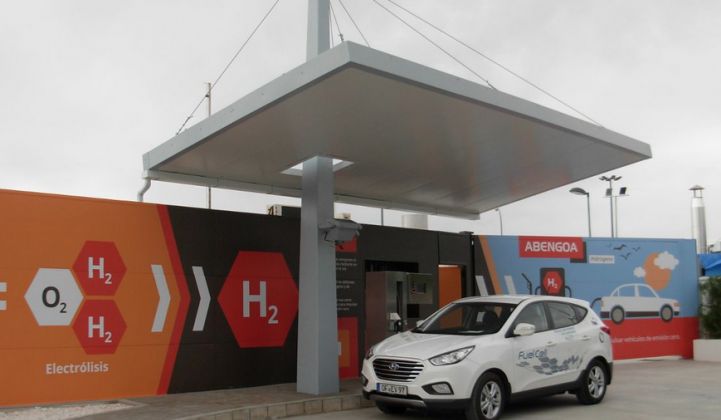Abengoa, the Spanish firm best known in America for biofuel, solar thermal, and water treatment plants, is looking to show off its hydrogen capabilities at home. Last month the company unveiled its second hydrogen filling station in Seville.
The in-situ hydrogen production facility, at Abengoa’s Torrecuéllar Industrial and Logistics Center, brings the total number of active filling stations in the country to just five. Abengoa built its first filling station in 2008 in Sanlúcar la Mayor, near Seville.
The station also creates hydrogen onsite, using renewable energy from solar PV. According to TÜV SÜD’s netinform database, the nonprofit Aragon Hydrogen Foundation has also installed two filling stations, near Zaragoza, in Aragon.
And Ajusa, an automotive components manufacturer, has a station in Albacete. All the facilities are for show, since hydrogen fuel-cell vehicles are essentially unknown in Spain.
The fact that Abengoa has built two filling stations so far also means it is Spain’s leading commercial hydrogen player, albeit in a very small field.
“Within Spain, there is really only Abengoa,” said María Luisa Revilla Trujillo, of the European Union programs division in the Spanish Center for Technological and Industrial Development, a government body. “They want to be leaders in hydrogen.”
Abengoa has been working on hydrogen for the last 17 years and has an entire business division, Abengoa Hidrógeno, devoted to the subject.
Among Abengoa Hidrógeno’s projects are a hydrogen-based energy storage system that has been operating since 2010 in Seville, as well as a number of co-generation plants. Abengoa Hidrógeno has also built hydrogen fuel systems for submarines and satellites.
With the Spanish hydrogen fuel-cell vehicle market yet to take off, Abengoa’s filling station forays so far appear to be more about proving the technology as an export asset rather than looking to meet domestic demand.
In particular, the Spanish press has cited California, Germany and the Nordic countries as possible destinations for Abengoa’s hydrogen expertise.
In the U.S., Abengoa is known to be exploring a range of new business lines, including the use of molten salt storage to replace peaker plants. “We are technology agnostic,” Abengoa Solar U.S. Marketing Director Amparo Pazos Cousillas has said.
The company has not said whether it intends to export its hydrogen expertise. But a recent Abengoa Hidrógeno corporate presentation claims the company is a “global player in hydrogen and fuel-cell technologies.”
Abengoa Hidrógeno chief Javier Brey has said in press statements he believes “it won’t be long” before the Spanish market starts to open up.
In June, the Spanish Ministry of Industry, Energy and Tourism launched a 30-point strategy to support the development of alternative-energy fueled vehicles.
The strategy, which mentions hydrogen fuel among a list of other options, is markedly at odds with the Ministry’s unfavorable stance on renewables and is mainly in response to a European Union directive from October 2014.
Nevertheless, the Spanish Hydrogen Association (Asociación Española del Hidrógeno or AeH2 in Spanish), which includes companies such as Abengoa and Gas Natural Fenosa, continues to make the case for more investment in hydrogen fuel development.
There are 22 research centers and around 350 researchers in Spain involved in hydrogen development, and Spanish authors account for almost 4 percent of papers on the subject.
The Association estimates Spain’s hydrogen market could be worth around €10 billion ($11 billion) by 2020 and €22 billion ($24 billion) by 2030. It also believes investment in a hydrogen economy could yield 800,000 jobs by 2030.
To achieve this, though, the Association estimates Spain must invest €245 million ($267 million) a year up until 2020. Installing 50 hydrogen fuel stations up until 2030 could cost about €50 million ($55 million), it says.
In a presentation this June, AeH2 vice-president Antonio González García-Conde contrasted these figures with Spain’s €15.5 billion ($16.9 billion) bill for annual oil imports.
“If the price of a barrel dropped by €1, it would cover all the investment needed for hydrogen and fuel cells,” he said.



